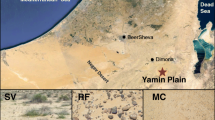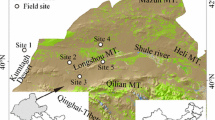Abstract
Whether grazed semi-arid grassland can be regarded as a net-sink or net-source of aeolian dust is difficult to detect since deposition and emission processes are in gradual transition. In grassland, dust arrives from sources far away or is directly emitted and immediately part of the suspension load. The processes of dust emission or deposition can be mainly identified by vertical concentration measurements close to the ground and close to the sources. Often the concentration differences at the used measuring heights are too small to derive the direction of vertical fluxes precisely, especially at dust storms of light-to-medium intensities. For this reason, particle mass (PM10, PM1) and particle number concentrations were measured simultaneously at ground level and at heights of up to 80 m using a dust monitoring system lifted by a kite. The measured data of dust concentration gradients are used to calculate the vertical fluxes with the necessary certainty to derive the direction of the dust fluxes. Additionally, dust arriving from different directions and crossing different land use/land cover patterns was used to interpret the interaction of source/sink relationships along the transport direction upstream of the measuring point. Results show that dust measurements above grassland have to span greater height differences to derive vertical fluxes certainly, i.e., concentration gradients (Δc/Δz) of PM10 and PM1 provide an indication of the direction of the dust flux. Furthermore, the results indicate a close relationship between the particle size compositions of the dust and land use/cover patterns. Arable land in the surroundings causes an emission flux (vertical upward), especially of the coarser fractions >8 µm, whereas grassland causes deposition fluxes of size classes >2 µm during a dust storm of low intensity. Sources from far away are reflected by higher concentrations of finer particles, measured during a super-regional dust storm. Both, dust concentration gradients and particle size composition reflect the potential source areas and deposition processes adequately with regard to different land use/cover patterns up to 50 km away.






Similar content being viewed by others
References
Alfaro S (2008) Influence of soil texture on the binding energies of fine mineral dust particles potentially released by wind erosion. Geomorphology 93:157–167
Andreae MO (1995) Climate effects of changing atmospheric aerosol levels. In: Henderson-Sellers A (ed) World survey of climatology 14. Future climates of the world—a modelling perspective. Elsevier, Amsterdam, pp 341–392
Angerer J, Han GD, Fujisaki I, Havstad K (2008) Climate change and ecosystems of Asia with emphasis on Inner Mongolia and Mongolia. Ranglands 30:46–51
Balsley BB, Jensen ML, Frehlich RG (1998) The use of state-of-art kites for profiling the lower atmosphere. Bound Layer Meteorol 87:1–25
Barthold F, Wiesmeier M, Breuer L, Frede HG, Wu J, Blank FB (2013) Land use and climate control the spatial distribution of soils in the grasslands of Inner Mongolia. J Arid Environ 88:194–205
Butterbach-Bahl K, Kögel-Knabner I, Han XG (2011) Steppes ecosystems and climate and land-use changes—vulnerability, feedbacks and possibilities for adaption. Plant Soil 340:1–6
Chen SP, Bai YF, Lin GH, Liang Y, Han XG (2005) Effects of grazing on photosynthetic characteristics of major steppe species in the Xilin River Basin, Inner Mongolia, China. Photosynthetica 43:559–565
Dong Z, Man D, Luo W, Qian G, Wang J, Zhao M, Liu S, Zhu G, Zhu Z (2010) Horizontal aeolian sediment flux in the Minqin area, a major source of Chinese dust storm. Geomorphology 116:58–66
FAO (2001) World-wide agroclimatic database. FAOCLIM 2. Environmental and Natural Resources Service, Agrometeorology Group, FAO, Rome
Fryrear DW (1986) A field dust sampler. J Soil Water Conserv 41:117–120
Funk R, Li Y, Hoffmann C, Reiche M, Zhang Z, Li J, Sommer M (2012) Using 137Cs to estimate wind erosion and dust deposition on grassland in Inner Mongolia—selection of a reference site and description of the temporal variability. Plant Soil 351:293–307
Funk R, Hoffmann C, Reiche M (2013) Methods for quantifying wind erosion in steppe regions. In: Mueller L, Saparov A, Lischeid G (eds) Novel measurement and assessment tools for monitoring and management of land and water resources in agricultural landscapes of Central Asia. Springer International Publishing, Dordrecht, pp 315–327
Gillette DA (1977) Fine particulate-emission due to wind erosion. Trans ASAE 20:890–897
Goossens D (2006) Aeolian deposition of dust over hills: the effect of dust grain sizes on deposition pattern. Earth Surf Process Landf 31:762–776
Goossens D, Offer ZY (2000) Wind tunnel and field calibration of six aeolian dust samplers. Atmos Environ 24:1043–1057
Grousset FE, Ginoux P, Bory A, Biscaye PE (2003) Cas study of a China dust plume reaching the French Alps. Geophys Res Lett 60:1277. doi:10.1029/2002GL016833
Herman JR, Bhartia PK, Torres O, Hsu C, Seftor C, Celarier E (1997) Global distribution of UV-absorbing areosols from Nimbus 7/TOMS data. J Geophys Res 102:16911–16922
Hoffmann C, Funk R, Wieland R, Li Y, Sommer M (2008a) Effects of grazing and topography on dust flux and deposition in the Xilingele Grassland, Inner Mongolia. J Arid Environ 72:792–807
Hoffmann C, Funk R, Sommer M, Li Y (2008b) Temporal variations in PM10 and particle size distribution during Asian dust storms in Inner Mongolia. Atmos Environ 42:8422–8431
Hoffmann C, Funk R, Reiche M, Li Y (2011) Assessment of extreme wind erosion and its impacts in Inner Mongolia, China. Aeolian Res 3:327–342
IPCC (2013) Climate Change 2013. The physical science basis. Contribution of Working Group I to the Fifth Assessment Report of the Intergovernmental panel on climate change. In: Stocker TF, Qin D, Plattner GK, Tignor M, Allen SK, Boschung J, Nauels A, Xia Y, Bex V, Midgley PM (eds). Cambridge University Press, Cambridge, p 1535
Kölbl A, Steffens M, Wiesmeier M, Hoffmann C, Funk R, Krümmelbein J, Reszkowska A, Zhao Y, Peth S, Horn R, Giese M, Kögel-Knabner I (2011) Grazing changes topography-controlled topsoil properties and their interaction on different spatial scales in a semi-arid grassland of Inner Mongolia, P.R. China. Plant Soil 340:35–58
Krümmelbein J, Perth S, Zhao Y, Horn R (2009) Grazing-induced alterations of soil hydraulic properties and functions in Inner Mongolia, PR China. J Plant Nutr Soil Sci 172:769–776
Lawrence CR, Neff JC (2009) The contemporary physical and chemical flux of aeolian dust: a synthesis of direct measurements of dust deposition. Chem Geol 267:46–63
Lee H, Tanaka H, Chiba M, Igarashi Y (2003) Long range transport of Asian dust from dust storms and its impact on Japan. Water Air Soil Pollut 3:231–343
Li SG, Harazono Y, Oikawa T, Zhao HL, Ying Z, Chang XL (2000) Grassland desertification by grazing and resulting micrometeorological changes in Inner Mongolia. Agric For Meteorol 102:125–137
McGowan HA, Clark A (2008) A vertical profile of PM10 dust concentration measured during a regional dust event identified by MODIS Terra Western Queensland. Australia. J Geophys Res 113:F02S03
McTanish G, Chan GY, McGowan HA, Leys J, Tews K (2005) The 23rd October 2002 dust storm in eastern Australia: characteristics and meteorological conditions. Atmos Environ 39:1227–1236
Okin GS (2005) Dependence of wind erosion and dust emission an surface heterogeneity: stochastic modeling. J Geophys Res 110:D11
Park SU, Park MS (2014) Aerosol size distribution observed at Naiman in the Asian dust source region of Inner Mongolia. Atmos Environ 82:17–23
Park SU, Cho JH, Park MS (2013) Identification of visibility reducing weather phenomena due to aerosols. Environ Manag Sustain Dev 2:126–142
Prospero JM, Ginoux P, Torres O, Nicholson SE, Gill TE (2002) Environmental characterisiation of global sources of atmospheric soil dust identified with the Nimbus 7 total ozone mapping spectrometer (TOMS) absorbing aerosol product. Rev Geophys 40:2–32
Rea DK, Hovan SA (1995) Grain-size distribution and distribution processes of the mineral component of abyssal sediments—lessons from the North Pacific. Paleoceanography 10:251–258
Reiche M, Funk R, Zhang Z, Hoffmann C, Li Y, Sommer M (2012a) Using a parafoil kite for measurement of variations in particulate matter—a kite-based dust profiling approach. J Atmos Clim Sci 2:41–51
Reiche M, Funk R, Zhang Z, Hoffmann C, Reiche J, Wehrhan M, Li Y, Sommer M (2012b) Application of satellite remote sensing for mapping wind erosion risk and dust emission-deposition in Inner Mongolia grassland, China. Grassl Sci 58:8–19
Schaffrath D, Barthold FK, Bernhofer C (2011) Spatiotemporal variability of grassland vegetation cover in a catchment in Inner Mongolia, China, derived from MODIS data products. Plant Soil 340:181–198
Shahsavani A, Naddafi K, Haghighifard NJ, Mesdaghinia A, Yunesian M, Nabizadeh R, Arahami M, Sowlat MH, Yarahmadi M, Saki H, Alimohamadi M, Nazmara S, Motevalian SA, Goudarzi G (2012) The evaluation of PM10, PM2.5, and PM1 concentrations during the Middle Eastern Dust (MED) events in Ahvaz, Iran, from April through September 2010. J Arid Environ 77:72–83
Shao Y (2000) Physics and modelling of wind erosion. Kluwer Academic Publishers, London
Shinoda M, Kimura R, Mikami M, Tsubo M, Nishihara E, Ishizuka M, Yamanda Y, Munkhtsetseg E, Jugder D, Kurosaki Y (2010) Characteristics of dust emission on the Mongolian Steppe: the 2008 DUVEX intensive observational period. SOLA 6:9–12
Shinoda M, Gillies JA, Mikami M, Shao Y (2011) Temperate grasslands as a dust source: knowledge, uncertainties, and challenges. Aeolian Res 3:271–293
Sterk G, Raats PAC (1996) Comparison of models describing the vertical distribution of wind eroded sediment. Soil Sci Soc Am J 60:1914–1919
Sterk G, Stein A, Stroosnijder L (2004) Wind effects on spatial variability in pearl millet yields in the Sahel. Soil Tillage Res 76:25–37
Tanaka TY, Chiba MA (2006) A numerical study of contributions of dust source regions to the global dust budget. Glob Planet Chang 52:88–104
Tegen I, Harrison SP, Kohfeld KE, Engelstaedter S, Werner M (2002) Emission of soil dust aerosol: anthropogenic contribution and future changes. Geochim Cosmochim Acta 66:A766
Tsoar H, Pye K (1987) Dust transport and the question of loess formation. Sedimentology 34:139–153
Wen HY, Niu DC, Fu H, Kang J (2013) Experimental investigation on soil carbon, nitrogen, and their components under grazing and livestock exclusion in steppe and dessert grassland, Northwestern China. Environ Earth Sci 70:3131–3141
WRB (2006) World reference base for soil resources. World Soil Research Reports 103. FAO, Rome
Zender CS, Miller RL, Tegen I (2004) Quantifying mineral dust mass budgets: terminology, constraints, and current estimates. EOS Trans 85:509–512
Zhang Z, Wieland R, Reiche M, Funk R, Hoffmann C, Li Y, Sommer M (2012) Identifying sensitive areas of wind erosion in the Xilingele grassland by computational fluid dynamics modelling. Ecol Infor 8:37–47
Zhao TL, Gang SL, Zhang XY, Blanchet JP, McKendry IG, Zhou ZJ (2006) A simulated climatology of Asia dust aerosol and its trans-Pacific transport. J Clim 19:88–103
Zobeck TM, Sterk G, Funk R, Rajot JL, Stout JE, Van Pelt RS (2003) Measurement and data analysis methods for field scale wind erosion studies and model validation. Earth Surf Process Landf 28:1163–1188
Acknowledgments
This work was funded by the Deutsche Forschungsgemeinschaft (Forschergruppe 536) as part of the Sino-German research project MAGIM ‘MAtter fluxes in Grasslands of Inner Mongolia as influenced by stocking rate’. The authors thank the German DAAD (Deutscher Akademischer Austauschdienst) for the support program and DAAD fellow. The authors also thank the anonymous reviewers for their assistance in improving this paper.
Author information
Authors and Affiliations
Corresponding author
Rights and permissions
About this article
Cite this article
Reiche, M., Funk, R., Hoffmann, C. et al. Vertical dust concentration measurements within the boundary layer to assess regional source–sink relations of dust in semi-arid grasslands of Inner Mongolia, China. Environ Earth Sci 73, 163–174 (2015). https://doi.org/10.1007/s12665-014-3404-5
Received:
Accepted:
Published:
Issue Date:
DOI: https://doi.org/10.1007/s12665-014-3404-5




